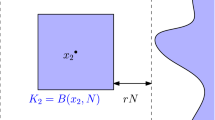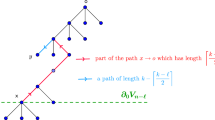Abstract
A prototype for variational percolation problems with surface energies is considered: the description of the macroscopic properties of a (two-dimensional) discrete membrane with randomly distributed defects in the spirit of the weak membrane model of Blake and Zisserman (quadratic springs that may break at a critical length of the elongation). After introducing energies depending on suitable independent identically distributed random variables, this is done by exhibiting an equivalent continuum energy computed using Γ-convergence, geometric measure theory, and percolation arguments. We show that below a percolation threshold the effect of the defects is negligible and the continuum description is given by the Dirichlet integral, while above that threshold an additional (Griffith) fracture term appears in the energy, which depends only on the defect probability through the chemical distance on the “weak cluster of defects”.
Similar content being viewed by others
References
Alicandro, R., Braides, A., Cicalese, M.: Continuum limits of discrete thin films with superlinear growth densities. Calc. Var. Partial Diff. Eq. (to appear)
Alicandro R., Cicalese M. (2004) A general integral representation result for continuum limits of discrete energies with superlinear growth. SIAM J. Math. Anal. 36, 1–37
Alicandro R., Focardi M., Gelli M.S. (2000) Finite-difference approximation of energies in fracture mechanics. Ann. Scuola Norm. Pisa (IV) 29, 671–709
Ambrosio L., Fusco N., Pallara D. (2000) Functions of Bounded Variation and Free Discontinuity Problems. Oxford University Press, Oxford
Blake A., Zisserman A. (1987) Visual Reconstruction. MIT Press, Cambridge
Braides, A.: Approximation of Free-Discontinuity Problems. Lecture Notes in Math., vol. 1694. Springer, Berlin, 1998
Braides A. (2002) Γ-convergence for Beginners. Oxford University Press, Oxford
Braides A., Chiadò Piat V. (1996) Integral representation results for functionals defined in SBV(Ω;I R m). J. Math. Pures Appl. 75, 595–626
Braides A., Dal Maso G., Garroni A. (1999) Variational formulation of softening phenomena in fracture mechanics: the one-dimensional case. Arch. Ration. Mech. Anal. 146, 23–58
Braides A., Francfort G. (2004) Bounds on the effective behavior of a square conducting lattice. R. Soc. Lond. Proc. Ser. A Math. Phys. Eng. Sci. 460, 1755–1769
Braides A., Gelli M.S.: The passage from discrete to continuous variational problems: a nonlinear homogenization process. Nonlinear Homogenization and its Applications to Composites, Polycrystals and Smart Materials (Eds. Ponte Castaneda P., Telega J.J. and Gambin B.) Kluwer, Dordrecht, pp. 45–63, 2004
Braides A., Solci M., Vitali E. (2007) A derivation of linear elastic energies from pair-interaction atomistic systems. Netw. Heterog. Media 2, 551–567
Chambolle A. (1992) Un théorème de Γ-convergence pour la segmentation des signaux. C. R. Acad. Sci., Paris, Ser. I 314, 191–196
Chambolle A. (1995) Image segmentation by variational methods: Mumford and Shah functional and the discrete approximations. SIAM J. Appl. Math. 55, 827–863
Cortesani G., Toader R. (1999) A density result in SBV with respect to non-isotropic energies. Nonlin. Anal. 38, 585–604
Dal Maso G. (1993) An Introduction to Γ-convergence. Birkhäuser, Boston
De Giorgi E., Ambrosio L. (1988) Un nuovo funzionale del calcolo delle variazioni. Atti Accad. Naz. Lincei Rend. Cl. Sci. Fis. Mat. Nat. 82, 199–210
Friesecke G., Theil F. (2002) Validity and failure of the Cauchy-Born hypothesis in a two-dimensional mass-spring lattice. J. Nonlin. Sci. 12, 445–478
Garet O., Marchand R. (2004) Asymptotic shape for the chemical distance and first-passage percolation on the infinite Bernoulli cluster. ESAIM Probab. Stat. 8, 169–199
Garet O., Marchand R. (2007) Large deviations for the chemical distance in supercritical Bernoulli percolation. Ann. Probab. 35, 833–866
Griffith A.A. (1920) The phenomenon of rupture and flow in solids. Phil. Trans. R. Soc. Lond. A 221, 163–198
Grimmett G.: Percolation, 2nd edn. Grundlehren der Mathematischen Wissenschaften, vol. 321. Springer, Berlin, 1999
Grimmett G., Kesten H. (1984) First-passage percolation, network flows and electrical resistances. Z. Wahrsch. Verw. Geb. 66, 335–366
Kesten H. (1982) Percolation theory for mathematicians. Progress in Probability and Statistics, vol. 2. Birkhäuser, Boston
Kesten H.: Aspects of first-passage percolation. Ècole d’été de probabilités de Saint-Fleur, XIV-1984. Lecture Notes in Math., vol. 180 (Ed. Hennequin P.L.) Springer, Heidelberg, pp. 125–262, 1986
Mumford D., Shah J. (1989) Optimal approximation by piecewise smooth functions and associated variational problems. Commun. Pure Appl. Math. 17, 577–685
Zhang Y., Zhang Y.C. (1984) A limit theorem for N 0n /n in first passage percolation. Ann. Probab. 12, 1068–1076
Author information
Authors and Affiliations
Corresponding author
Additional information
Communicated by G. Friesecke
Rights and permissions
About this article
Cite this article
Braides, A., Piatnitski, A. Overall Properties of a Discrete Membrane with Randomly Distributed Defects. Arch Rational Mech Anal 189, 301–323 (2008). https://doi.org/10.1007/s00205-008-0114-8
Received:
Accepted:
Published:
Issue Date:
DOI: https://doi.org/10.1007/s00205-008-0114-8




